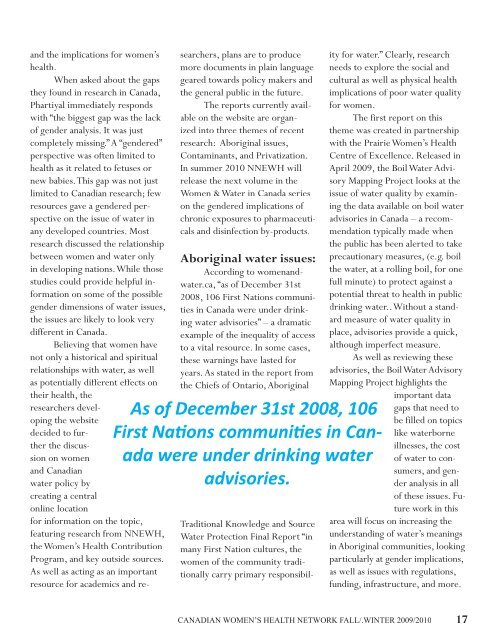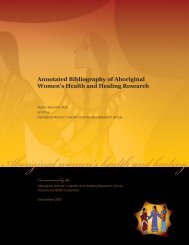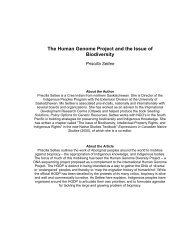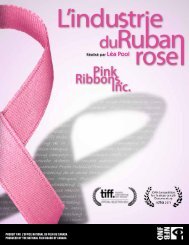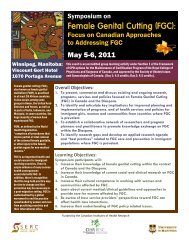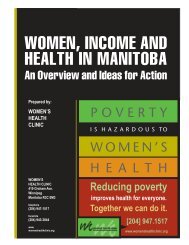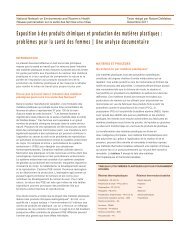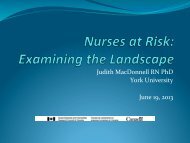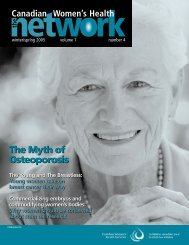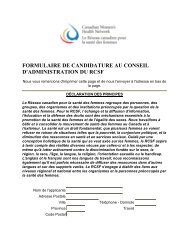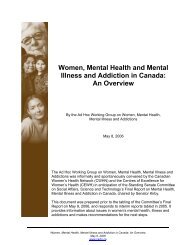Network 12-1.pdf - Canadian Women's Health Network
Network 12-1.pdf - Canadian Women's Health Network
Network 12-1.pdf - Canadian Women's Health Network
Create successful ePaper yourself
Turn your PDF publications into a flip-book with our unique Google optimized e-Paper software.
and the implications for women’s<br />
health.<br />
When asked about the gaps<br />
they found in research in Canada,<br />
Phartiyal immediately responds<br />
with “the biggest gap was the lack<br />
of gender analysis. It was just<br />
completely missing.” A “gendered”<br />
perspective was often limited to<br />
health as it related to fetuses or<br />
new babies. This gap was not just<br />
limited to <strong>Canadian</strong> research; few<br />
resources gave a gendered perspective<br />
on the issue of water in<br />
any developed countries. Most<br />
research discussed the relationship<br />
between women and water only<br />
in developing nations. While those<br />
studies could provide helpful information<br />
on some of the possible<br />
gender dimensions of water issues,<br />
the issues are likely to look very<br />
different in Canada.<br />
Believing that women have<br />
not only a historical and spiritual<br />
relationships with water, as well<br />
as potentially different effects on<br />
their health, the<br />
searchers, plans are to produce<br />
more documents in plain language<br />
geared towards policy makers and<br />
the general public in the future.<br />
The reports currently available<br />
on the website are organized<br />
into three themes of recent<br />
research: Aboriginal issues,<br />
Contaminants, and Privatization.<br />
In summer 2010 NNEWH will<br />
release the next volume in the<br />
Women & Water in Canada series<br />
on the gendered implications of<br />
chronic exposures to pharmaceuticals<br />
and disinfection by-products.<br />
Aboriginal water issues:<br />
According to womenandwater.ca,<br />
“as of December 31st<br />
2008, 106 First Nations communities<br />
in Canada were under drinking<br />
water advisories” – a dramatic<br />
example of the inequality of access<br />
to a vital resource. In some cases,<br />
these warnings have lasted for<br />
years. As stated in the report from<br />
the Chiefs of Ontario, Aboriginal<br />
As of December 31st 2008, 106<br />
First Naons communies in Canada<br />
were under drinking water<br />
advisories.<br />
Traditional Knowledge and Source<br />
Water Protection Final Report “in<br />
many First Nation cultures, the<br />
women of the community traditionally<br />
carry primary responsibil-<br />
researchers developing<br />
the website<br />
decided to further<br />
the discussion<br />
on women<br />
and <strong>Canadian</strong><br />
water policy by<br />
creating a central<br />
online location<br />
for information on the topic,<br />
featuring research from NNEWH,<br />
the Women’s <strong>Health</strong> Contribution<br />
Program, and key outside sources.<br />
As well as acting as an important<br />
resource for academics and reity<br />
for water.” Clearly, research<br />
needs to explore the social and<br />
cultural as well as physical health<br />
implications of poor water quality<br />
for women.<br />
The first report on this<br />
theme was created in partnership<br />
with the Prairie Women’s <strong>Health</strong><br />
Centre of Excellence. Released in<br />
April 2009, the Boil Water Advisory<br />
Mapping Project looks at the<br />
issue of water quality by examining<br />
the data available on boil water<br />
advisories in Canada – a recommendation<br />
typically made when<br />
the public has been alerted to take<br />
precautionary measures, (e.g. boil<br />
the water, at a rolling boil, for one<br />
full minute) to protect against a<br />
potential threat to health in public<br />
drinking water.. Without a standard<br />
measure of water quality in<br />
place, advisories provide a quick,<br />
although imperfect measure.<br />
As well as reviewing these<br />
advisories, the Boil Water Advisory<br />
Mapping Project highlights the<br />
important data<br />
gaps that need to<br />
be filled on topics<br />
like waterborne<br />
illnesses, the cost<br />
of water to consumers,<br />
and gender<br />
analysis in all<br />
of these issues. Future<br />
work in this<br />
area will focus on increasing the<br />
understanding of water’s meanings<br />
in Aboriginal communities, looking<br />
particularly at gender implications,<br />
as well as issues with regulations,<br />
funding, infrastructure, and more.<br />
CANADIAN WOMEN’S HEALTH NETWORK FALL/.WINTER 2009/2010 17


